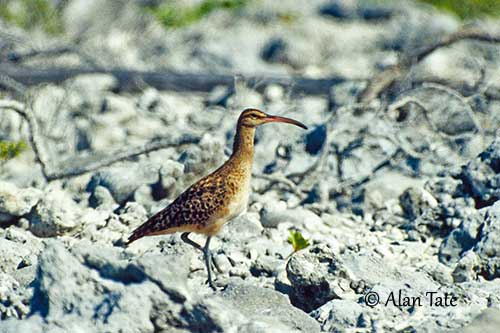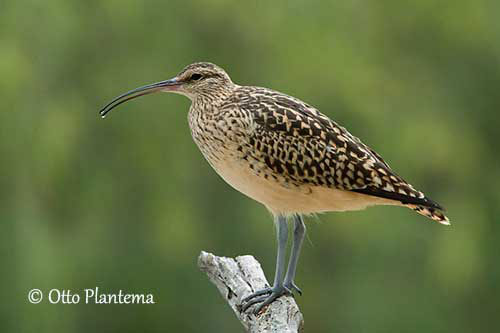
Fr: Courlis d’Alaska
Ang: Bristle-thighed Curlew
All: Borstenbrachvogel
Esp: Zarapito del Pacífico
Ita: Chiurlo setoloso
Nd: Zuidzeewulp
Sd: alaskaspov
Photographers:
Otto Plantema
Trips around the world
William Price
PBase-tereksandpiper & Flickr William Price
Alan & Ann Tate
AA Bird Photography
Text by Nicole Bouglouan
Sources :
HANDBOOK OF THE BIRDS OF THE WORLD Vol 3 by Josep del Hoyo-Andrew Elliott-Jordi Sargatal - Lynx Edicions - ISBN : 8487334202
GUIDE DES LIMICOLES de D. Taylor - Delachaux et Niestlé - ISBN : 2603014080
SHOREBIRDS by Peter Hayman, John Marchant and Tony Prater – Christopher Helm – 1986 – ISBN: 0747014035
Wikipedia, the free encyclopaedia
The Birds of North America online
Alaska Science Center – Shorebird Research
U.S. Fish & Wildlife Service – Hawaiian Islands
Bristle-thighed Curlew
Numenius tahitiensis
Charadriiformes Order – Scolopacidae Family
INTRODUCTION:
The Bristle-thighed Curlew is a rare bird and the only shorebird known to have a flightless moult during the winter. It is threatened by predators during this period because it cannot fly.
It nests in the tundra in W Alaska, but during the winter, it can be seen on beaches, reefs, mudflats and grassy fields on islands in South Pacific Ocean. It flies non-stop for over 4,000 kilometres to reach the wintering grounds.
It feeds on berries and insects during the nesting season, but in winter, crustaceans, snails, small fish, insects and eggs of seabirds are part of the diet.
The Bristle-thighed Curlew is threatened by introduced predators, especially during the flightless period. It also suffers loss and degradation of the habitat and hunting. It is currently listed as Vulnerable with a small population.

DESCRIPTION OF THE BIRD:
Biometrics:
Length: 40-44 cm
Wingspan: 82-90 cm
Weight: M: 254-553 g – F: 372-796 g
The Bristle-thighed Curlew has dark brown upperparts speckled with cinnamon-buff, but rump and uppertail-coverts are plain cinnamon.
The underparts are white on lower breast and belly, whereas upper breast and throat are pale buff speckled with brown. The underwing is orange-buff with brown bars. The bristly feathers on thighs, giving the bird its name, are difficult to see in the field.
The head is broadly striped, making this bird very similar to the Whimbrel, with a pale stripe down the centre of the crown.
The rather heavy bill is fairly long and down-curved. It has flesh-coloured base and dark tip. The eyes are dark brown. Legs and feet are bluish-grey and thick.
The female has similar plumage, but she is heavier with longer wings and shorter bill.
The juvenile resembles adult, but upperparts and wing coverts show larger, conspicuous cinnamon-buff spotting. The breast is more buffish with indistinct streaking.
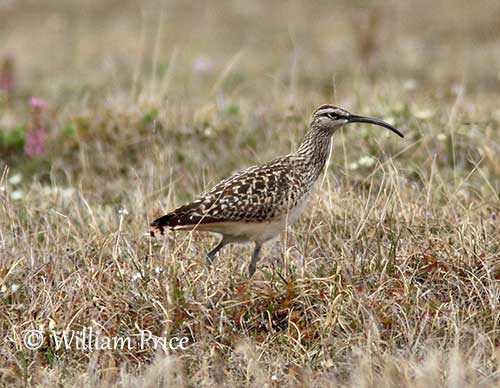
RANGE:
The Bristle-thighed Curlew breeds in W Alaska from Seward Peninsula to Yukon Delta.
It winters from Marshall Is and Hawaiian Is, S to Santa Cruz (Temotu), E Solomons, Fiji, Tonga, Samoa, Marquesas, Tuamotu Is and Pitcairn Is.
HABITAT:
The Bristle-thighed Curlew breeds in W Alaska in open tundra with scattered shrubs, usually well inland in steep hilly country.
It winters on islands in South Pacific Ocean, and can be seen on beaches, coral reefs, mudflats and grassy fields, but also in narrow channels between islets and around seabird’s colonies.
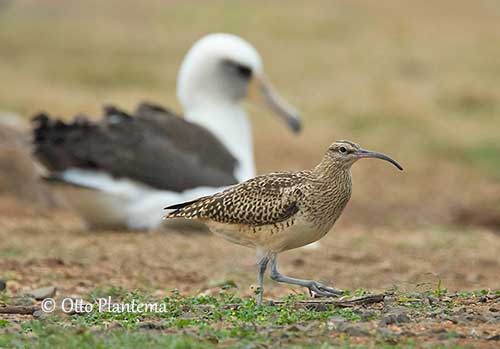
CALLS AND SONGS: SOUNDS BY XENO-CANTO
The Bristle-thighed Curlew gives a long, plaintive whistle “too-lee”, a short rippling whistle ‘whe-whe-whe-whe” and a ringing “whee-wheeoo”. At least seven vocalizations are identified.
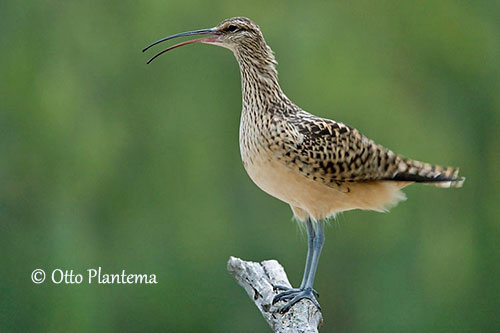
BEHAVIOUR IN THE WILD:
The Bristle-thighed Curlew feeds on various berries, spiders and insects during the breeding season. Among insects, beetles, moths, butterflies and larval insects are taken.
On the wintering grounds, it feeds on crustaceans, insects, spiders, snails and lizards, but also carrion and fish regurgitated by seabirds. It may occasionally eat the eggs of various large seabirds. It opens the egg with the bill, or drops it on hard surface, but some stone tools can be used too.
The Bristle-thighed Curlew forages by walking and picking up prey from the ground. It probably probes soil and mud with the long bill.
It is usually seen alone or in small groups of 5-6 individuals. They roost in trees or on roofs.
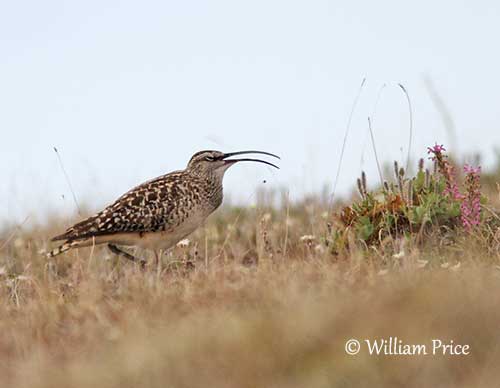
At the beginning of the breeding season, the male performs spectacular aerial displays over the nesting site, soaring over its territory while uttering various complex singing phrases.
This species nests on the ground and both adults share the nesting duties.
The Bristle-thighed Curlew is migratory and travels in small groups. The birds usually gather at Yukon Delta in W Alaska to build fat reserves prior to the nonstop flight of over 4,000 kilometres to reach the wintering islands in South Pacific Ocean. They leave the breeding grounds from early July, followed by juveniles in early August.
The Bristle-thighed Curlew is able to make long-distance flights over open ocean while migrating. During the moult of the flight feathers when they arrive at the oceanic islands, they become completely flightless during two weeks, making them vulnerable to predation.
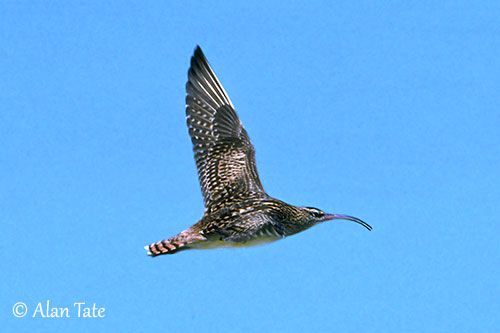
REPRODUCTION OF THIS SPECIES:
The laying starts in mid-May/late May. The Bristle-thighed Curlew has large territory of up to 275 ha in open tundra. The nest is a shallow depression on the ground, lined with lichen, moss and leaves. It is often placed under a dwarf willow.
The female lays 4 olive-buff eggs with brown markings. Both adults share the incubation during about 25 days. The downy chicks leave the nest soon after hatching. They are tended by both parents but they are able to feed themselves.
The adults defend strongly the nest and the young. They may perform distraction display to lead the predators away from the nest-site.
A few days later, the family leaves the nest-site and may join other families on hilltops.
The female usually departs first, leaving the male to care for young until they fledge, about 21-27 days after hatching.
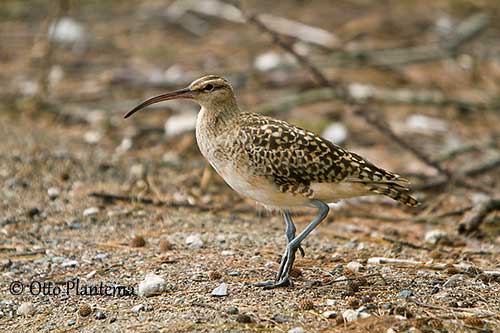
PROTECTION / THREATS / STATUS:
The Bristle-thighed Curlew is threatened by dogs, cats and pigs introduced on islands during the flightless period.
Clearance for coconut plantations may involve degradation and habitat loss. Hunting pressure occurs in some islands in the wintering areas. Predation by Parasitic Jaeger, Common Raven and foxes occurs during the breeding season.
The species will be threatened in next future by habitat changes and rising water levels due to climate change.
The population is estimated to number 10,000 individuals, with 7,000 mature birds and 3,000 immatures. It is suspected to be declining moderately.
The Bristle-thighed Curlew is currently listed as Vulnerable.
